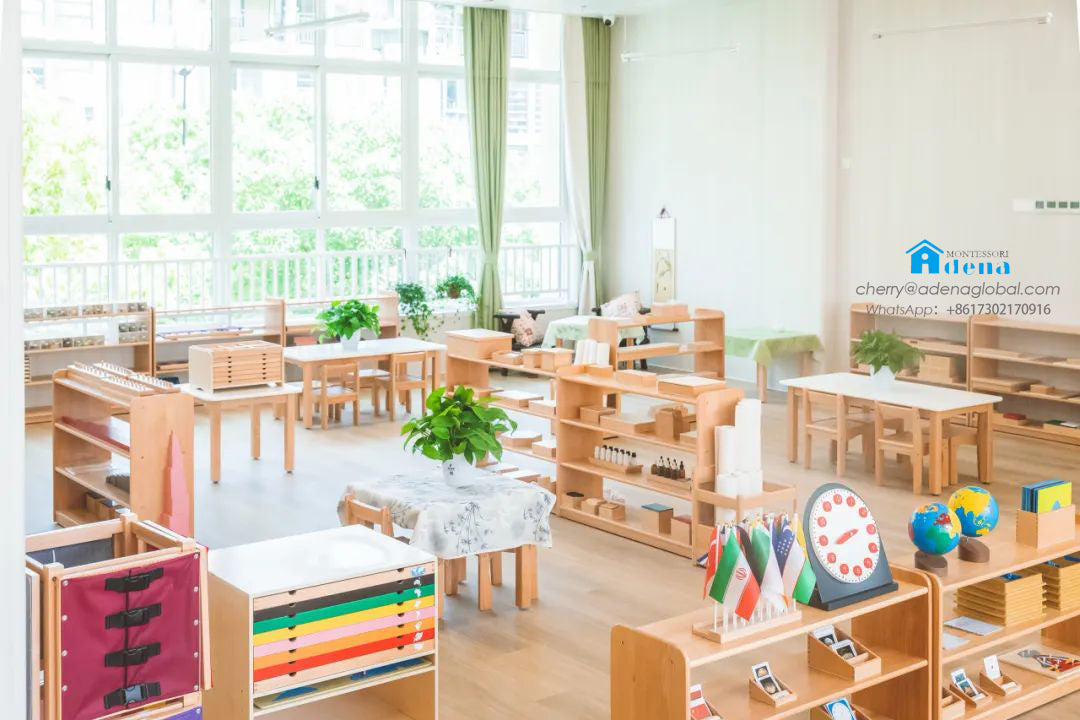
What is Montessori CASA Classroom?
Share
In the first stage of human development, ages 3-6 are a period of consolidation and enhancement of the abilities acquired during the 0-3 years stage.

Therefore, when a child enters the Casa classroom, they already possess the basic skills acquired from ages 0-3. They can express themselves verbally, and some children can articulate their thoughts clearly. They have basic hand movements, such as holding a cup, which, although not yet very skilled, are sufficient for survival in this world. They use their senses to perceive and understand the world, knowing the taste and smell of food, and having some initial experiences of different textures. They use simple mathematical principles, such as turning their head to talk to family members, which requires good control over the angle of head rotation.

All of these abilities are absorbed and constructed in the child’s psychological senses and movements during the 0-3 years stage. As the child enters the latter half of the first stage, their mind undergoes significant changes, gradually understanding the classification of the world, the order of the environment, and a series of logical relationships.
How does the child achieve this?
How does the environment for ages 3-6 help the child accomplish these?

Practical Life Area:
This includes Preliminary Preparations, Care of Person, Care of the Environment, Control of Movement, and Grace and Courtesy.
Preliminary preparations are represented by basic actions such as pouring grains, pouring water, folding cloths, and screwing bottle caps. These activities help children precisely master the most basic fine motor skills, satisfying the muscle development of fine movements and laying a foundation for subsequent complex and comprehensive tasks.
Control of movement is exemplified by walking on the line, helping children better control their large body movements, gradually understanding their physical capabilities, and moving freely.
Self-care activities include button frames, zipper frames, hand-washing, combing hair, cutting paper, cutting fruits, tea ceremonies, dressing and folding clothes, and toilet training. Real tools and materials help children integrate the use of their body and fine motor skills to achieve self-care in daily life.
Care of the environment activities include polishing mirrors, polishing brass, polishing wood, washing cloths, washing tables, flower arranging, taking care of plants, taking care of animals, and food preparation.
Comprehensive tasks help children establish awareness of the group and environment, contribute to the beautification of the environment, smoothly enter social environments, develop a sense of responsibility, and establish spontaneous self-discipline and awareness of rules.

Sensorial Area:
The senses are divided into Visual Sense, Tactile Sense, Auditory Sense,Olfactory Sense, Gustatory Sense, and Stereognostic Sense.
Visual Sense: Activities include the Pink Tower, Brown Stairs, Cylinder Blocks, Color Tablets, Geometric Cabinet, Binomial Cube, Trinomial Cube, and Constructive Triangles. These activities help children refine their visual discrimination skills. Children trained in visual exercises will develop sharper observational skills, enabling them to distinguish subtle differences between similar objects and recognize various shapes, colors, sizes, and lengths. This aids in better information categorization and organization, fostering the development of logical thinking.
Tactile Sense: Activities include Touch Boards, Rough and Smooth Boards, Fabric Box, Thermic Bottles, Thermic Tablets, and Baric Tablets. These activities enhance children's tactile discrimination and fingertip sensitivity. Through tactile exercises, children will develop more agile fingers and quickly identify the texture, temperature, and weight of objects, thus enhancing their cognitive understanding of the world.
Auditory Sense: Activities include Sound Cylinders and Bells. These activities refine children's auditory skills, enabling them to distinguish between different volumes and pitches, laying the foundation for musical arts.
Gustatory Sense: Activities include Taste Bottles, which provide opportunities for children to experience various flavors, stimulating their taste abilities.
Olfactory Sense: Activities include Smelling Bottles, which help children recognize various scents in nature and everyday life, enhancing their olfactory sensitivity.
Stereognostic Sense: Activities include Geometric Solids, Mystery Bag, and Sorting Trays. These activities enhance children's ability to perceive object shapes using their bodies rather than just vision and touch, helping them recognize the names of various three-dimensional shapes and fostering the development of their stereognostic skills.

Mathematics Area:
Mathematics is divided into six parts: Numbers 1-10, Decimal System, Counting, Memory, Path to Abstraction, and Fractions.
Numbers 1-10: Activities include Number Rods, Spindle Box, Cards and Counters, Number Memory Game, and Zero Game. These activities help children recognize quantities and numbers from 1 to 10, understand the concept of zero, and establish correct one-to-one correspondence during their sensory development stage.
Decimal System: Activities include Golden Beads, Number Cards, Bank Game, Stamp Game, Dot Game, and Word Problems. These activities help children understand the decimal system and perform addition, subtraction, multiplication, and division within a thousand based on the decimal system.
Counting: Activities include Teen Boards, Ten Boards, Short Bead Chains, and Long Bead Chains. These activities help children expand their counting ability from 10 to 1000, understand the decimal place value system, and master continuous and skip counting, laying the foundation for abstract mathematics.
Memory: Activities include Addition Snake Game, Addition Strip Board, Subtraction Snake Game, Subtraction Strip Board, Multiplication Bead Bars, Multiplication Board, Division Board, and Division Tables. These activities help children enter the memory mode of decimal operations, gradually mastering the basic rules and methods of the four operations through practice, and enhancing their memory of arithmetic formulas.
Path to Abstraction: Activities include Small Bead Frame, Large Bead Frame, Geometric Hierarchy Of Number with Cards, and Tube Division. These activities help children enter the more efficient field of abstract mathematical cognition and operations, achieving numerical operations in the millions for the four operations.
Fractions: Activities include Fraction Insets, which help children understand how wholes are divided, learn the notation of fractions, and perform equivalent, addition, subtraction, multiplication, and division operations with fractions.

Language Area:
Language is divided into four parts: Oral Language, the Key to Reading and Writing, the Path to Total Reading, and Writing.
Oral Language is represented by self-expression, vocabulary expansion, classification cards, stories, poetry, songs, and sound games. It helps children express their thoughts using appropriate words, sentences, and different literary forms, enhancing their literary appreciation skills.
The key to reading and writing is represented by three-part cards, sandpaper letters, movable alphabet, writing desks, and writing sand trays. It helps children recognize and write letters, use different words to form sentences, and lay the foundation for complete reading and writing.
Writing is represented by the movable alphabet, writing games, metal insets, sandpaper letters, and writing models. It helps children master letter writing skills, correct pencil grip, correct strokes, and proper writing methods, appreciate different types of text, and experience different writing tools.
The path to total reading is represented by the functions of words (adjectives, logical adjectives, detective adjectives, conjunctions, prepositions, verbs, adverbs, logical adverbs), punctuation, command cards, reading analysis, word study, and three-stage definition books. It helps children master the grammar structure of sentences and paragraphs, the use of punctuation, accurately understand the correct meaning of articles, and improve reading ability and speed.


Culture Area:
Culture is divided into six parts: the world, the plant world, the animal world, the art world, the science world, and the music world.
The world is represented by terrestrial and aquatic globes, colored globes, land and water models, geography puzzles, national flags, geography classification cards, national culture cards, terrain definition books, and clay crafts. It helps children understand the world, continents, countries, national flags, and experience the races, customs, cultures, clothing, and food of various countries, opening a window for children to explore the world.
The plant world is represented by plant care, leaf shape charts, leaf shape cards, plant experiments, plant insets, plant evolution, plant classification cards, and plant definition books. It helps children understand the composition of plants, distinguish different shapes of leaves, flowers, and fruits, explore the structure of leaves, flowers, and fruits, and understand the natural environment required for plant growth.
The animal world is represented by animal care, animal insets, insect insets, animal classification cards, animal definition books, animal development and evolution, and animal morphology evolution. It helps children understand the classification of animals, the body structure of animals, and the names of different parts.
The art world is represented by easel painting, puzzles, origami, embroidery, making pompoms, weaving, collage, watercolor painting, pencil drawing, clay, printmaking, artist introduction, and famous painting appreciation. It opens the door to art for children, allowing them to freely explore the field of art. By providing children with world famous painting appreciation and artist introduction, children can better understand the art world and establish their own artistic life and goals.
The science world is represented by scientific observation, scientific experiments, understanding scientists, and understanding scientific phenomena. It helps children have a basic understanding of natural scientific phenomena happening around them, laying a foundation for future scientific and cultural learning.
The music world is represented by sound bells, instrument classification cards, composer introduction, instrument performance, singing, and using a CD player to appreciate different types of music. It helps children understand the forms of music, master the rhythm, melody, and tonality of music by recognizing the meaning represented by music. By experiencing and practicing different types of instruments, it further enhances their understanding and knowledge of world culture.

